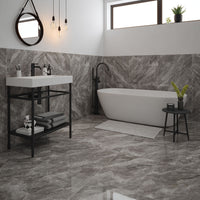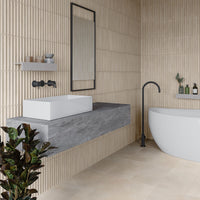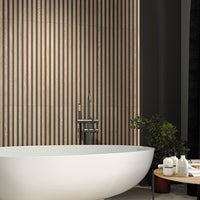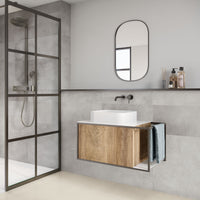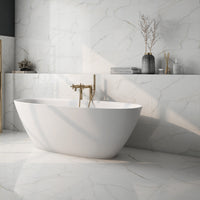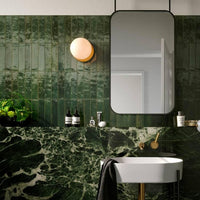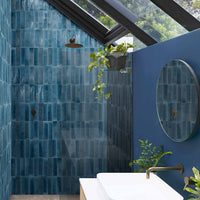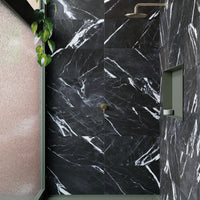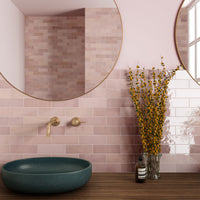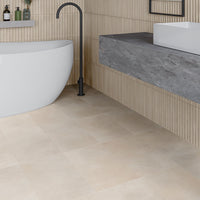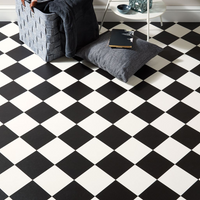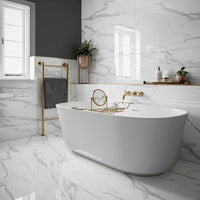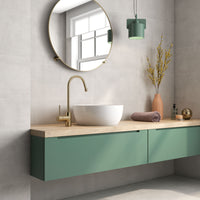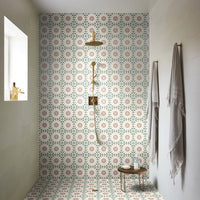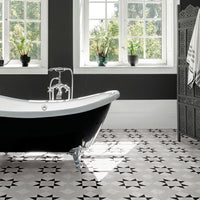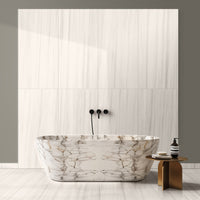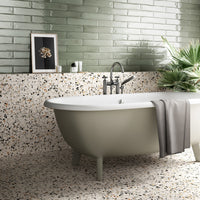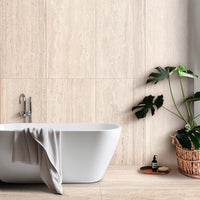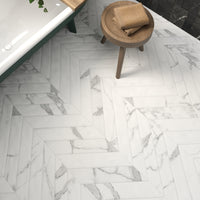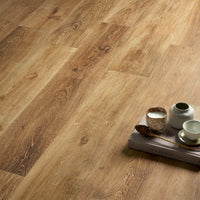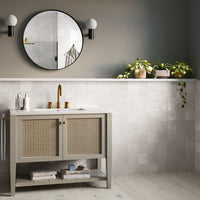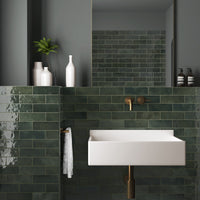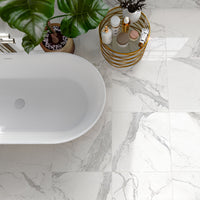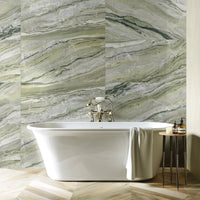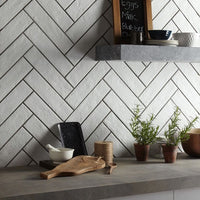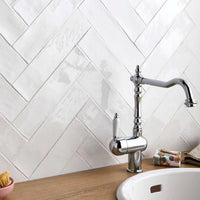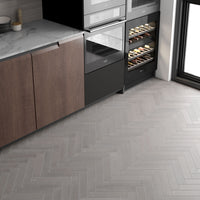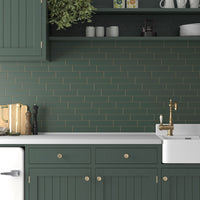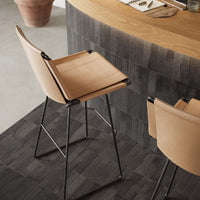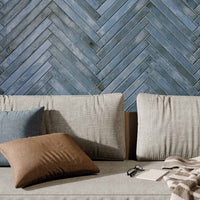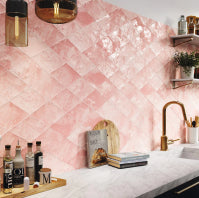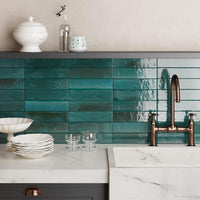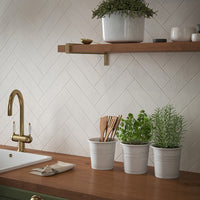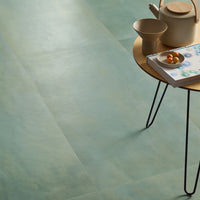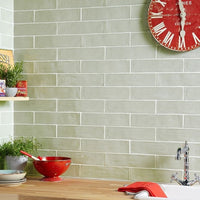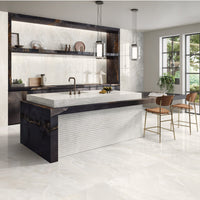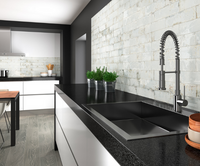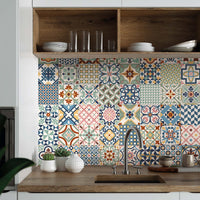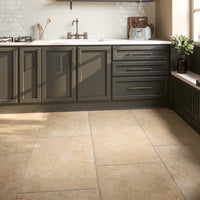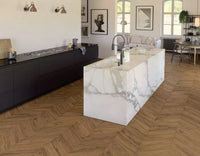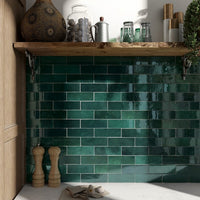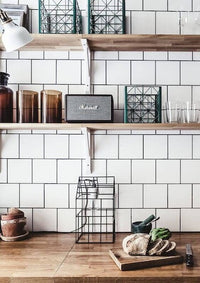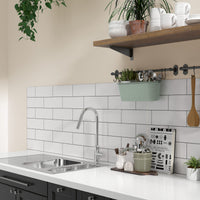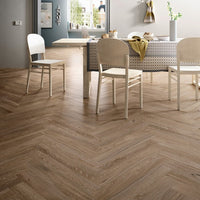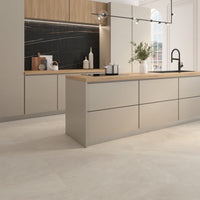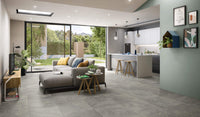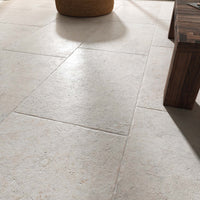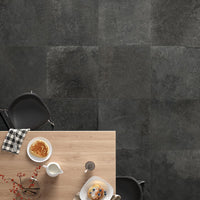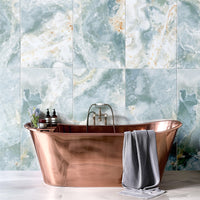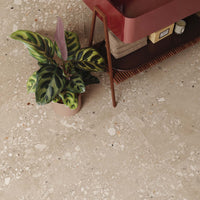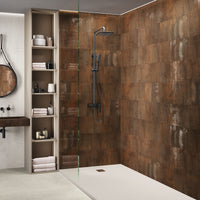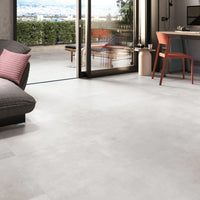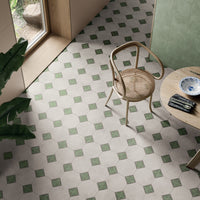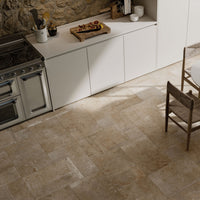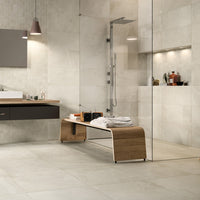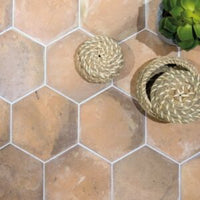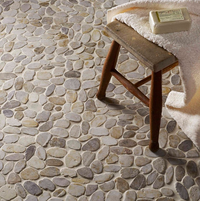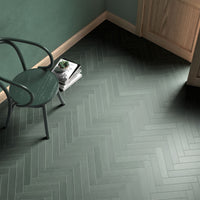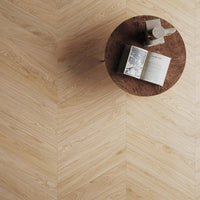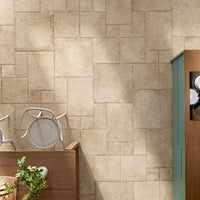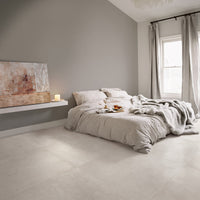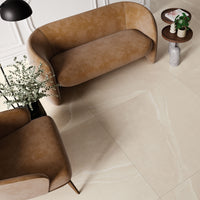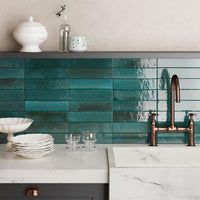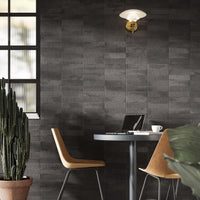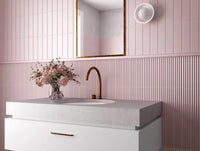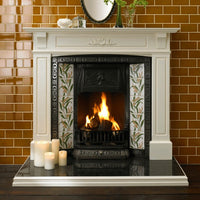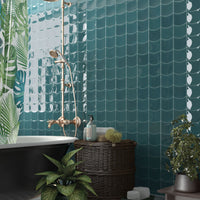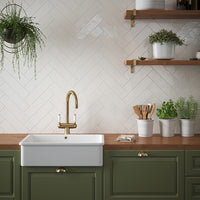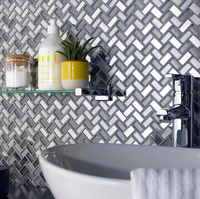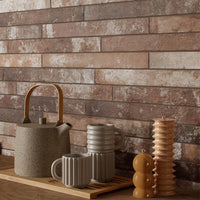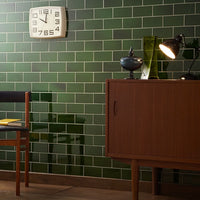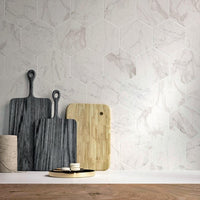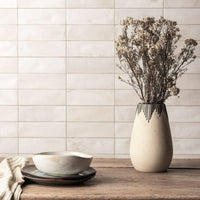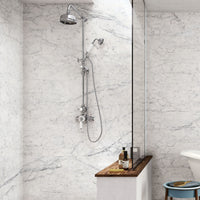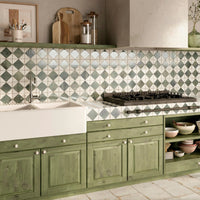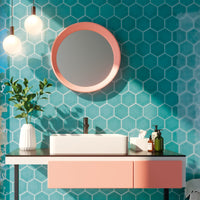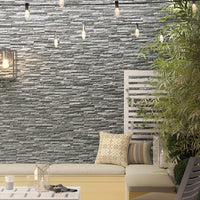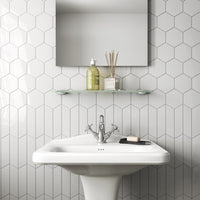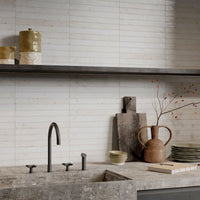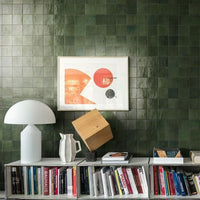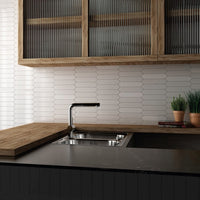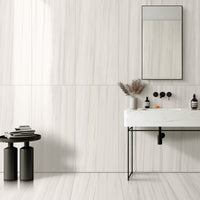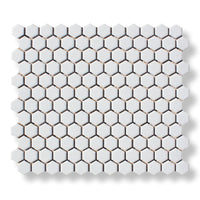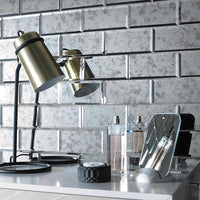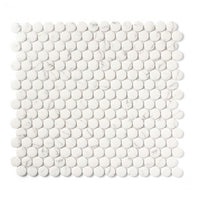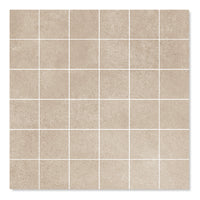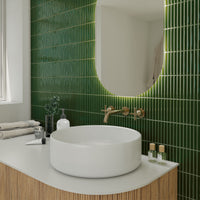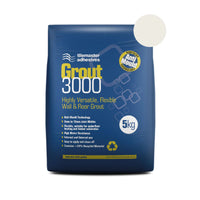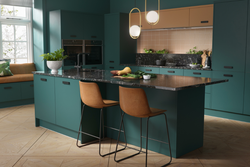If all this tile talk is driving you nutty then you’re in the right place. Our glossary below covers all the essential tile-related jargon so you’ll know your porcelains from your ceramics quicker than a fast-setting adhesive…
Tile Types
Carrara Marble
Carrara is a naturally occurring marble, mined from quarries in northern Tuscany, Italy. With its dazzling white background and blue-grey veining, Carrara marble has been cherished for thousands of years. However it is expensive and requires a high level of care, and these days excellent man-made porcelain alternatives are available.
Cement Tiles
As the name suggests, cement tiles are made from powdered cement. They’re usually patterned and consist of two or more patterns of coloured cement. After being formed into a mould, they are hydraulically pressed and left to cure, usually outside in the sun. Unlike many decorative ceramic and porcelain tiles, the pattern runs through the whole body of the tile. However, cement tiles aren’t frost-proof so are only suitable for use indoors.
Ceramic Tile
Ceramic tiles usually have a clay base and a layer of decorative glaze. They’re fired in a kiln at extremely high temperatures to fuse the layer together. These days, ceramic tiles are generally used for wall tiles and for floor tiles that don’t receive heavy foot traffic.
Encaustic Tiles
It’s easy to confuse encaustic with cement tiles, as both are often unglazed patterned tiles. However, traditional encaustic tiles are produced from firing two or more colours of clay together. This makes them frost-proof and suitable for use outside. You’ll find plenty of examples of period encaustic tiles throughout the UK however these day, ceramic and porcelain offer the encaustic look without the price tag.
Full Bodied Porcelain
Sometimes referred to as unglazed porcelain, full bodied porcelain tiles don’t have a glaze surface; the main colour and pattern of the surface runs all the way through the body of the tile. Full bodied porcelain tiles are incredibly hard-wearing which makes them perfect for heavy duty commercial floors such as shops and restaurants.
Glazed Porcelain
Glazed porcelain tiles consist of a porcelain body with a glazed decorative layer on top. They’re much harder wearing than traditional ceramic tiles which means they’re perfect for use throughout the home. The majority of our glazed porcelain tiles are produced using inkjet printing technology, meaning they’re extremely lifelike.
Limestone Tiles
Limestone is a naturally occurring sedimentary rock. It’s traditionally found in soft beige and grey tones and often contains clusters of shells and marine fossils. Extremely realistic replicas are available, which combine the warmth of natural limestone with the practicality of porcelain tile.
Natural Stone Tiles
Natural stone has been used as a building material for thousands of years and popular types include marble, slate, granite, limestone and travertine. Natural stone tiles are cut from quarried rock and as they are a product of nature, no two pieces are ever alike. Whilst natural stone tiles are undeniably beautiful they can be extremely expensive to purchase and install and usually require a high degree of ongoing maintenance.
These days, incredibly lifelike porcelain and ceramic versions of popular stones are available, which combine the beauty of stone with the durability of man-made materials.
Marble Tiles
One of the most coveted natural stones, marble is a metamorphic rock that’s formed when limestone is exposed to incredibly high pressures in the earth’s crust. White marbles such as Bianco Carrara have been prized for thousands of years but other types such as Nero Marquina are equally dramatic. Marble tiles are suitable for indoor use but they are usually extremely expensive to purchase and install.
Mosaic Tiles
Dating back to ancient times, mosaic tiles are patterns made up of thousands of tiny chips, called tesserae. Wealthy ancient Romans and Greeks would use mosaics artists to create scenes of everyday life; these days, we tend to use mosaics to create feature wall and floors. Most mosaics are made from glass, ceramic or natural stones and are mounted onto mesh sheets to aid installation.
Porcelain Tile
Technically speaking, porcelain tiles are a type of ceramic with a water absorption rate of less than 0.5 percent. They’re crafted from fine raw materials and fired at higher temperatures than traditional ceramic tiles – this results in a finished product that’s extremely durable and resistant to wear. Porcelain tiles are usually available as either full-bodied or glazed porcelain tiles.
Slate Tiles
As with marble, slate is a metamorphic rock that’s formed when shale is compressed over long periods of time. It’s extremely durable so it’s a popular choice for roof tiles and flooring but it’s also quite brittle and it’s very easy to cleave slate into thin sheets. Because of this, natural slate floor tiles may chip or split quite easily.
Terracotta Tiles
The name terracotta translates from Italian as ‘baked earth’ and that’s essentially what terracotta tiles are – slabs of clay fired in a kiln. The familiar red, yellow and pink tones we associate with terracotta are due to the iron content present in the clay. Although terracotta floor tiles have been used for hundreds of years, they are quite porous and easy to stain.
Quarry
The name can be a bit misleading; unlike natural stone, quarry tiles don’t come from a quarry! Instead, ground raw materials are mixed together, ‘extruded’ into tile forms and then fired at high temperatures. The resulting quarry tiles are unglazed and extremely hard, which makes them suitable for a variety of floor areas. They’re also resistant to water so can be used outside.
Tile Finishes
Anti slip
Anti slip floor tiles provide extra grip underfoot, so they’re ideal for wet areas where you may want extra peace of mind.
Bevelled edge
Wall tiles with a bevelled edge finish have a chamfered finish so the edges of the tile are slightly lower than the main body, to give a distinctive finish. Metro tiles are a classic bevelled edge tile.
Brushed
Tiles with a brushed finish have a lightly textured surface with rounded edges. It’s a common finish for some natural stones such as marble and is achieved by brushing the surface with hard steel brushes.
Crackle Glaze
Crackle tiles feature hairline cracks on the surface, which gives them a unique vintage style. These are created deliberately during the manufacturing process and must be sealed before the tiles are grouted, to prevent staining.
Inkjet Printing
Many of today’s glazed tiles are produced using inkjet printing, where the decoration is printed onto the tile in a similar way to how your office printer works. This process may also be called digital printing and it allows for sharper, more realistic tile designs than ever before.
Lappato
Lappato tiles have a unique semi-polished finish that sits somewhere between matt and polished. The surface of the tiles is lightly polished by an abrasive wheel to give a partially reflective surface. They usually provide the best of both worlds; reflecting light like polished tiles and offering more slip resistance, like a matt surface.
Matt
Many floor tiles and some wall tiles have a matt finish, with a dull, unpolished surface. They may be completely flat or have some texture – for example, matt wood effect planks often have a gently undulating surface to mimic the bumps and lumps of real timber. Some matt tiles offer extra anti-slip properties.
Polished
As the name suggests, polished tiles have a smooth, highly-reflective finish. This is achieved by buffing unglazed porcelain or natural stone tiles with an abrasive diamond wheel, creating a shine without a glaze. Polished porcelain tiles are usually extremely hard wearing but offer less slip resistance than matt or textured floor tiles.
Split Face
Ideal for feature walls, split face tiles are made from textured strips of natural stone. These are cut to different lengths and thicknesses and pieced together to give a natural, handmade finish. Porcelain split face wall tiles are now available which offer more durability and performance in wet areas.
Textured
Tiles with a textured or riven finish have a raised, tactile surface. Compared to a matt tile, they usually offer more slip resistance so make an excellent choice where slip may be an issue. Many textured tiles have certified anti-slip finishes for added peace of mind.
Technical and Installation
Adhesive
Tile adhesives are required to bond tiles to wall and floor substrates. These are usually either cement-based adhesives for porcelain and natural stone, or ready-mixed paste adhesive for smaller ceramic wall tiles.
Backer Board
Cement or foam tile backer boards should be used when tiling onto chipboard or floorboards. They are easy to install and provide a level and water-resistant surface that’s perfect for tiling. Certain boards have excellent thermal insulation properties so are recommended if you’re using underfloor heating. Backer boards can also be installed on wet walls as an alternative to plasterboard, for additional peace of mind.
Bowing
All kiln-fired tiles tend to have a slight bow, so the middle piece of the tile is higher than the edges. It is important to note that a certain amount of bowing – or warpage – is acceptable under European standards. When tiles are laid in a regular pattern, bowing usually isn’t evident. However, for longer plank tiles laid with random joints, bowing may be more obvious. It is recommended to offset plank tiles by no more than 33% of the length of the tile.
Expansion Joint
Certain floors, especially larger areas with underfloor heating, may expand and contract due to heat, etc. Expansion or movement joints must be installed in these spaces to prevent tiles from cracking or de-bonding from the substrate below.
Grout
Grout is a cement mix used to fill the grout joint between tiles. It comes in a variety of colours to compliment or contrast against the tiles and helps achieve a professional, sealed finish.
Grout Joint
Tiles will inevitably experience some movement, so it’s not advisable to butt them close together. Instead, a grout joint is used to allow tiles to move without cracking or coming loose. Tile spacers come in a variety of sizes and help aid spacing during installation.
Nominal Sizing
In the tile world, the nominal size describes the approximate dimensions of the tile for general identification purposes, rather than the exact size. Nominal sizes tend to be familiar, such as 30 x 60 cm; however the tile inside the box may be slightly larger or smaller.
Rectified
A rectified tile has mechanically finished edges that are cut at a precise 90-degree angle. In addition, the tiles will be ground to a exact size so they can be laid with a smaller grout joint, for a more contemporary finish.
PEI Rating
Although tiles in general are hardwearing, some tiles are more resistant to wear and tear than others. The PEI system is used to grade floor tiles according to their hardness.
Sealer
Some tiles are porous and must be sealed during installation with a suitable tile sealer. This prevents grout, liquids and dirt from penetrating and staining the tile. Most ceramic and porcelain tiles do not need to be sealed, with the exception of some polished porcelains and all crackle glaze tiles. Most natural stones will require treatment.
Shade Variation
Many tiles are designed to mimic natural materials and will differ from piece to piece. The difference in colour, texture and tone is known as shade variation and is an inherent characteristic of all tiles. Tiles are rated from V1 (very little variation) to V4 (lots of variation).
Slip Resistance
For some applications, slip resistant tiles will be preferred for extra safety. Some tiles may have a textured, grooved or rough surface that offers greater slip resistance underfoot. Although difference anti-slip ratings are available, the ‘R Value’ is the most commonly used. Tiles may be graded from R9 to R13 according to the degree of slip resistance offered – an R13 rating offers a higher degree of resistance than an R9 tile.
Water Absorption
Water absorption refers to the capacity for water to penetrate the tile. By their very definition, porcelain tiles have a very low water absorption rate of less than 0.5% and are highly impervious to water. This makes them suitable for almost any internal or external application. In contrast, ceramic tiles have higher levels of water absorption and should not be used outside as they are liable to crack.
